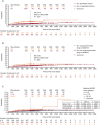Psychiatric adverse events in three phase III trials of eslicarbazepine acetate for focal seizures
- PMID: 35908275
- PMCID: PMC9712463
- DOI: 10.1002/epi4.12635
Psychiatric adverse events in three phase III trials of eslicarbazepine acetate for focal seizures
Abstract
Objective: Eslicarbazepine acetate (ESL) is a once-daily (QD), oral anti-seizure medication for the treatment of focal (partial-onset) seizures. Here, we evaluate risk factors for the development of psychiatric treatment-emergent adverse events (TEAEs) in clinical trials of adjunctive ESL in adults with focal seizures.
Methods: This post-hoc analysis evaluated data pooled from three Phase III, randomized, double-blind, placebo-controlled trials (BIA-2093-301, -302, -304). After an 8-week baseline period, patients were randomized equally to receive placebo, ESL 400 mg (not reported here), 800 mg, or 1200 mg QD (up to 2-week titration; 12-week maintenance; optional open-label extension [OLE]). Incidences of psychiatric TEAEs were evaluated according to three separate criteria: medical history of psychiatric disorders (yes/no); baseline use of psychotropic drugs (yes/no); Montgomery-Åsberg Depression Rating Scale (MADRS) score at baseline (0-6: normal; 7-19: mild depression; 20-34: moderate depression).
Results: The analysis populations comprised 1251 patients for the controlled study period and 1137 patients for the 1-year OLE. Psychiatric TEAE incidence was similar between patients taking ESL and placebo in the controlled and OLE study periods and was not related to ESL dose. Psychiatric TEAEs generally occurred more frequently in patients with a medical history of psychiatric disorders, using psychotropic drugs, or with depressive symptoms than in those without a history, not using psychotropic drugs, or with no depressive symptoms. Depression and anxiety were the most frequently reported psychiatric TEAEs.
Significance: Overall, in clinical trials of ESL in adults with focal seizures, incidences of psychiatric events were not statistically different between patients taking ESL and placebo, were not related to ESL dose, and generally occurred more frequently in patients with baseline psychiatric symptoms or a history of psychiatric disorders. Long-term exposure to ESL was not associated with a marked increase in the incidence of psychiatric TEAEs.
Keywords: anxiety; depression; eslicarbazepine acetate; focal seizures; psychiatric; psychotropic.
© 2022 The Authors. Epilepsia Open published by Wiley Periodicals LLC on behalf of International League Against Epilepsy.
Conflict of interest statement
Hamada Altalib: consultant/advisory board for Eisai; research grant from VA Healthcare System and US Department of Defense CDMRP Epilepsy Research Program; other research support from Sunovion Pharmaceuticals Inc., UCB, Engage, Eisai, and Epilepsy Consortium. Todd Grinnell, David Cantu, and Yi Zhang: employees of Sunovion Pharmaceuticals Inc. Fábio Ikedo and Mariana Vieira: employees of BIAL – Portela & Cª, S.A. David Blum: paid consultant to Sunovion Pharmaceuticals Inc. Note that Sunovion Pharmaceuticals Inc acquired the rights to eslicarbazepine acetate in the United States and Canada markets under an exclusive license from BIAL– Portela & Cª.
Figures


Similar articles
-
Psychiatric and cognitive adverse events: A pooled analysis of three phase III trials of adjunctive eslicarbazepine acetate for partial-onset seizures.Epilepsy Behav. 2018 May;82:119-127. doi: 10.1016/j.yebeh.2017.12.017. Epub 2018 Mar 28. Epilepsy Behav. 2018. PMID: 29604484
-
Tolerability of adjunctive eslicarbazepine acetate according to concomitant lamotrigine or carbamazepine use: A subgroup analysis of three phase III trials in adults with focal (partial-onset) seizures.Epilepsy Res. 2018 Nov;147:80-86. doi: 10.1016/j.eplepsyres.2018.08.011. Epub 2018 Aug 29. Epilepsy Res. 2018. PMID: 30278294 Clinical Trial.
-
Influence of titration schedule and maintenance dose on the tolerability of adjunctive eslicarbazepine acetate: An integrated analysis of three randomized placebo-controlled trials.Epilepsy Res. 2018 Jan;139:1-8. doi: 10.1016/j.eplepsyres.2017.10.021. Epub 2017 Nov 4. Epilepsy Res. 2018. PMID: 29127848 Clinical Trial.
-
Safety Profile of Eslicarbazepine Acetate as Add-On Therapy in Adults with Refractory Focal-Onset Seizures: From Clinical Studies to 6 Years of Post-Marketing Experience.Drug Saf. 2017 Dec;40(12):1231-1240. doi: 10.1007/s40264-017-0576-4. Drug Saf. 2017. PMID: 28752473 Free PMC article. Review.
-
Eslicarbazepine acetate: its effectiveness as adjunctive therapy in clinical trials and open studies.J Neurol. 2017 Mar;264(3):421-431. doi: 10.1007/s00415-016-8338-2. Epub 2017 Jan 18. J Neurol. 2017. PMID: 28101651 Free PMC article. Review.
Cited by
-
The efficacy and safety of third-generation antiseizure medications and non-invasive brain stimulation to treat refractory epilepsy: a systematic review and network meta-analysis study.Front Neurol. 2024 Jan 9;14:1307296. doi: 10.3389/fneur.2023.1307296. eCollection 2023. Front Neurol. 2024. PMID: 38264091 Free PMC article.
-
A real-world pharmacovigilance analysis of eslicarbazepine acetate using the FDA adverse events reporting system (FAERS) database from 2013 (Q4) to 2024 (Q1).Front Pharmacol. 2024 Sep 20;15:1463560. doi: 10.3389/fphar.2024.1463560. eCollection 2024. Front Pharmacol. 2024. PMID: 39372199 Free PMC article.
References
-
- Dussaule C, Bouilleret V. Psychiatric effects of antiepileptic drugs in adults. Geriatr Psychol Neuropsychiatr Vieil. 2018;16(2):181–8. - PubMed
-
- Kanner AM. Psychiatric comorbidities in new onset epilepsy: should they be always investigated? Seizure. 2017;49:79–82. - PubMed
-
- Blaszczyk B, Czuczwar SJ. Epilepsy coexisting with depression. Pharmacol Rep. 2016;68(5):1084–92. - PubMed
-
- Kanner AM. Management of psychiatric and neurological comorbidities in epilepsy. Nat Rev Neurol. 2016;12(2):106–16. - PubMed
Publication types
MeSH terms
Substances
Grants and funding
LinkOut - more resources
Full Text Sources
Medical

